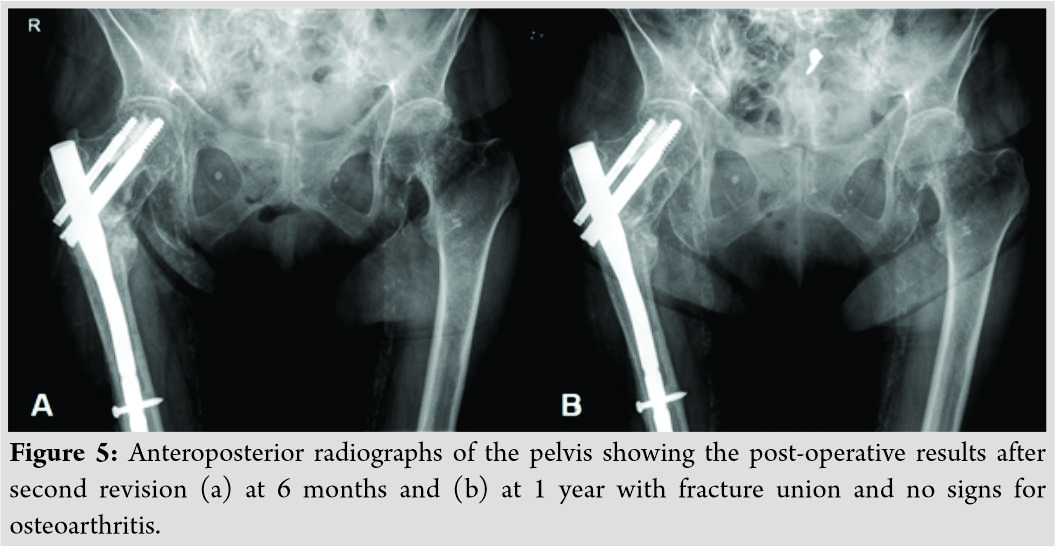[box type=”bio”] Learning Point of the Article: [/box]
The lateral cortical notching technique facilitates fracture union in cephalomedullary nailing of trochanteric fractures with fracture lines extending to the lateral cortical bone underneath the lateral border of the cephalomedullary screw by dynamic axial loading along the femoral shaft axis.
Case Report | Volume 10 | Issue 6 | JOCR September 2020 | Page 5-8 | Christian Tinner, Nicolas Andreas Beckmann, Johannes Dominik Bastian. DOI: 10.13107/jocr.2020.v10.i06.1852
Authors: Christian Tinner[1], Nicolas Andreas Beckmann[1], Johannes Dominik Bastian[1]
[1]Department of Orthopaedic Surgery and Traumatology, Inselspital, Bern University Hospital, University of Bern, Switzerland.
Address of Correspondence:
Dr. Johannes Dominik Bastian,
Department of Orthopaedic Surgery and Traumatology, Inselspital, Bern University Hospital, University of Bern, , Freiburgstrasse 3, 3010 Bern, Switzerland.
E-mail: johannes.bastian@insel.ch
Abstract
Introduction: Trochanteric fractures are common in elderly patients. Subtrochanteric fracture patterns are challenging due to the risk for non-union.
Case Report: We report a case of an 87-year-old woman with a subtrochanteric fracture treated with a cephalomedullary nail. A cutout of the blade occurred in the early follow-up and was treated with exchange nailing elsewhere. Late nail breakage due to non-union more than 4 years after exchange nailing was noted. The fracture healed uneventfully after revision at our institution with exchange nailing including the lateral cortical notching technique whilst applying osteoinductive supplements.
Conclusion: From our point of view, the concept of lateral cortical notching should be taken into consideration to enhance treatment of subtrochanteric non-unions by exchange nailing.
Keywords: Proximal femoral nail, non-union, nail breakage, bone healing, lateral cortical notching, diamond concept, implant failure.
Introduction
Trochanteric fractures of the femur are common in elderly patients with osteoporosis and rise progressively with age so that between the ages of 80 and 85 years, hip fractures account for up to 36% of all osteoporotic fractures [1]. Most trochanteric fractures require surgical treatment providing early rehabilitation [2]. Cephalomedullary nails, screws, or plate fixation are the most common techniques for fixation of these fractures [3, 4]. For fracture fixation, it is important to understand the fracture pattern and localization of fracture lines to differentiate between stable and unstable fractures. Comminution of the medial femoral cortex at the level of the lesser trochanter results in unstable fractures and challenges stable fixation [5, 6]. In addition, instability is noted particularly in fractures with subtrochanteric extension. An optimal mechanical situation with axial loading and adequate stability of the fracture site is important for the physiological process leading to a successful bone repair response. Accordingly, unstable fractures with limited contact surface area, with the risk for interposing soft tissue, decreased vascularity of bone and high mechanical loads are at risk for non-union [7, 8, 9]. Furthermore, without any revision surgery, repetitive loading and micromotion enabled by a non-union might lead to nail fatigue breakage [10].
Case Report
An 87-year-old woman with known osteoporosis fell on her right hip with subsequent pain and immobility and presented elsewhere. Radiographs revealed a multifragmentary intertrochanteric fracture with subtrochanteric extension and mild preexisting hip osteoarthritis (Fig. 1a). Two days later, an open reduction and osteosynthesis with a cephalomedullary nail (Proximal Femoral Nail Antirotation®, PFN-A 125°, DePuy Synthes, Raynham, Massachusetts, USA), with cerclage of the trochanter minor was performed (Fig. 1b). One-week post-surgery, the patient was discharged to rehabilitation center with allowed full weight-bearing with a walking frame.
Further 2 weeks later, the patient suffered from immediate aggravation of pain without a previous event. A radiographic control showed an articular cutout of the blade and revision surgery was undertaken with implant removal and exchange nailing using (Proximal Femoral Nail®, PFN 125°; DePuy Synthes, Raynham, Massachusetts, USA) and application of demineralized bone matrix (cyclOS®, Mathys Medical AG, Bettlach, Switzerland; DBX®, J&J Medical Devices, New Brunswick, New Jersey, USA) (Fig. 2a, b). The mobilization was restricted to no weight-bearing with only bed-wheelchair transfer allowed. On 6 and 12 weeks follow-up, the patient was free of pain with strict non-weight-bearing. Radiographs showed progressive consolidation. After 3 months of restriction, full weight-bearing was allowed and physiotherapeutic measures for strengthening recommended. At the 1-year follow-up, the patient was satisfied and only felt pain in stress situations (e.g., hometrainer activity). 
Full weight-bearing was allowed and the patient discharged to a rehabilitation clinic 1 week post-surgery. At the 6 and 12 months follow-up, the patient was completely free of pain and has achieved equal ambulation as before revision surgery. The radiographs showed a complete consolidation of the fracture with unchanged position of the nail (Fig. 5a, b).
Discussion
The inter- and subtrochanteric region of the femur is a common localization for fractures resulting from low-energy falls in the elderly [9]. The reviewed case shows a treatment with a cephalomedullary nail (PFN, DePuy Synthes, Raynham, Massachusetts, USA), a recommended implant for these fractures. Nail breakage is a rare complication and similar results are reported. Rappold et al. reported two cases of nail breakage at the hole for the femoral neck screw in 61 patients with subtrochanteric fractures treated with PFN (DePuy Synthes, Raynham, Massachusetts, USA). Iwakura et al. reported in 2013 a review of the literature and found a range from 0.2% to 5.7% for nail breakage [13]. Johnson et al. analyzed 221 cases of AO 31 fractures with 22 (10%) nail breakages through the hole for the femoral neck screw [6]. There are no cephalomedullary nail implants reported in literature that are not susceptible to nail breakage [14]. We know that the hole for the femoral neck screw is the “locus minoris resistentiae,” because forces from the femoral neck are transmitted to the nail and into the femoral shaft at the smallest diameter hole. The subtrochanteric fracture location was most susceptible for nail breakage and non-union and malreduction were important reasons [6]. Fracture stability also plays a role in implant failure as higher implant failure rates were reported for groups with unstable fracture models in a biomechanical study [15]. There are different reported surgical techniques for handling cases of non-union. In general, the dynamization of the nail is a common method to allow fracture impaction and firm interfragmental contact in cases of hypertrophic non-unions. Removal of the distal locking screw allows the nail to glide downward within the medullary cavity. In contrast, in the presence of fractures below the lateral end of the blade, the distal lateral cortical bone blocks gliding of the nail distally and impedes fracture dynamization. Accordingly, removal of the blocking bone is recommended and has been described previously by others [11]. Further, Giannoudis et al. reviewed that a successful fracture healing is dependent on the biological environment at the fracture site with availability of progenitor cells and matrix, molecular mediators, and immunoregulatory cells. Deficit in the biological or mechanical environment, the lack of vascularity, and failure to appreciate the comorbidities of the host lead to an impaired fracture healing response and ultimately in non-union. The so-called diamond concept refers to the availability of osteoinductive mediators, osteogenic cells, an osteoconductive matrix (scaffold), optimal mechanical environment, and adequate vascularity. By addressing any existing comorbidities of the host, a favorable outcome is more likely, thus all modifiable patient dependent risk-factors should be optimized [16]. Non-union following infection, biological compromise due to the trauma or surgical exposure and/or malreduction with impaired mechanical environment is reasons for failure in trochanteric fractures treated with cephalomedullary nails. In our case of elderly woman, a highly unstable fracture pattern and diminished bone support due to implant positioning, the focus was set on the obvious reason of insufficient biologic healing response. Although possible septic causes were ruled out and biologic aspects were optimized with osteoinductive factors in the first revision, non-union was persistent. We suspect that due to the subtrochanteric fracture pattern, the femoral neck screw at the lateral cortex blocked axial loading resulting in a poor biomechanical environment inhibiting bone healing. In contrast, any biologic compromise on bone healing was probably not the main origin for failure. Without the later intended dynamization, the load was transferred through the nail and no load between the bone fragments was achieved, leading to an insufficient healing response. A nail breakage after 5 years is late and not typical, but because of aggravating symptoms, the ambulatory activity was gradually reduced, and the frequency of repetitive load declined. Compared to other reported cases of non-union with mechanical problems, in our case, the initially supposed reduced biology with poor bone quality and poor blood supply was additional to the mechanical problem (e.g., static locking). Even the extramedullary bone was initially touched with a cerclage. Further, protection of the viable bone and soft tissue as well as minimally invasive revision surgery with correct choice and positioning of the implant were key points in the final revision. Mechanical stability was achieved, autologous bone graft (with growth factors and scaffold), and an osteoinductive agent (BMP) supported biology.
Conclusion
Fracture reduction and correct use of implants for fracture fixation are essential for fracture union. Unstable trochanteric fractures are at risk for non-union and consecutive implant failure. In the presented case, fracture impaction was required along the femoral shaft axis instead of the femoral neck axis for fracture union. Once the surgical technique with fracture fixation by a cephalomedullary nail was advanced with the lateral cortical notching technique the fracture healed following that optimization of the biomechanical environment even in an older patient with previous surgery compromising biology.
Clinical Message
The lateral cortical notching technique was successfully used as a salvage procedure in a rare case of trochanteric fracture non-union with fatigue breakage of a cephalomedullary nail in elderly patient.
References
1. Johnell O, Kanis JA. An estimate of the worldwide prevalence and disability associated with osteoporotic fractures. Osteoporos Int 2006;17:1726-33.
2. Handoll HH, Parker MJ. Conservative versus operative treatment for hip fractures in adults. Cochrane Database Syst Rev 2008;3:CD000337.
3. Webb LX. Proximal femoral fractures. J South Orthop Assoc 2002;11:203-12.
4. Hou Z, Bowen TR, Irgit KS, Matzko ME, Andreychik CM, Horwitz DS, et al. Treatment of pertrochanteric fractures (OTA 31-A1 and A2): Long versus short cephalomedullary nailing. J Orthop Trauma 2013;27:318-24.
5. Ruff ME, Lubbers LM. Treatment of subtrochanteric fractures with a sliding screw-plate device. J Trauma 1986;26:75-80.
6. Johnson NA, Uzoigwe C, Venkatesan M, Burgula V, Kulkarni A, Davison JN, et al. Risk factors for intramedullary nail breakage in proximal femoral fractures: A 10-year retrospective review. Ann R Coll Surg Engl 2017;99:145-50.
7. Maniscalco P, Rivera F, D’Ascola J, Del Vecchio EO. Failure of intertrochanteric nailing due to distal nail jamming. J Orthop Traumatol 2013;14:71-4.
8. Rollo G, Tartaglia N, Falzarano G, Pichierri P, Stasi A, Medici A, et al. The challenge of non-union in subtrochanteric fractures with breakage of intramedullary nail: Evaluation of outcomes in surgery revision with angled blade plate and allograft bone strut. Eur J Trauma Emerg Surg 2017;43:853-61.
9. Bedi A, Le TT. Subtrochanteric femur fractures. Orthop Clin North Am 2004;35:473-83.
10. French BG, Tornetta P 3rd. Use of an interlocked cephalomedullary nail for subtrochanteric fracture stabilization. Clin Orthop Relat Res 1998;348:95-100.
11. Biber R, Bail HJ, Stedtfeld HW. Lateral cortical notching in specific cases of delayed unions or nonunions after intertrochanteric and reversed fractures. Arch Orthop Trauma Surg 2013;133:495-501.
12. Zhang Y, Zhang S, Wang S, Zhang H, Zhang W, Liu P, et al. Long and short intramedullary nails for fixation of intertrochanteric femur fractures (OTA 31-A1, A2 and A3): A systematic review and meta-analysis. Orthop Traumatol Surg Res 2017;103:685-90.
13. Iwakura T, Niikura T, Lee SY, Sakai Y, Nishida K, Kuroda R, et al. Breakage of a third generation gamma nail: A case report and review of the literature. Case Rep Orthop 2013;2013:172352.
14. Rollo G, Rinonapoli G, Pichierri P, Bisaccia M, Caraffa A, Meccariello L. Breakage in two points of a short and undersized affixus cephalomedullary nail in a very active elderly female: A case report and review of the literature. Case Rep Orthop 2018;2018:9580190.
15. Eberle S, Bauer C, Gerber C, von Oldenburg G, Augat P. The stability of a hip fracture determines the fatigue of an intramedullary nail. Proc Inst Mech Eng H 2010;224:577-84.
16. Andrzejowski P, Giannoudis PV. The diamond concept for long bone non-union management. J Orthop Traumatol 2019;20:21.
 |
 |
 |
| Dr. Christian Tinner | Dr. Nicolas Andreas Beckmann | Dr. Johannes Dominik Bastian |
| How to Cite This Article: Tinner C, Beckmann NA, Bastian JD. Lateral Cortical Notching in Revision of a Subtrochanteric Fracture Non-union with Breakage of a Cephalomedullary Nail. Journal of Orthopaedic Case Reports 2020 September;10(6): 5-8. |
[Full Text HTML] [Full Text PDF] [XML]
[rate_this_page]
Dear Reader, We are very excited about New Features in JOCR. Please do let us know what you think by Clicking on the Sliding “Feedback Form” button on the <<< left of the page or sending a mail to us at editor.jocr@gmail.com






